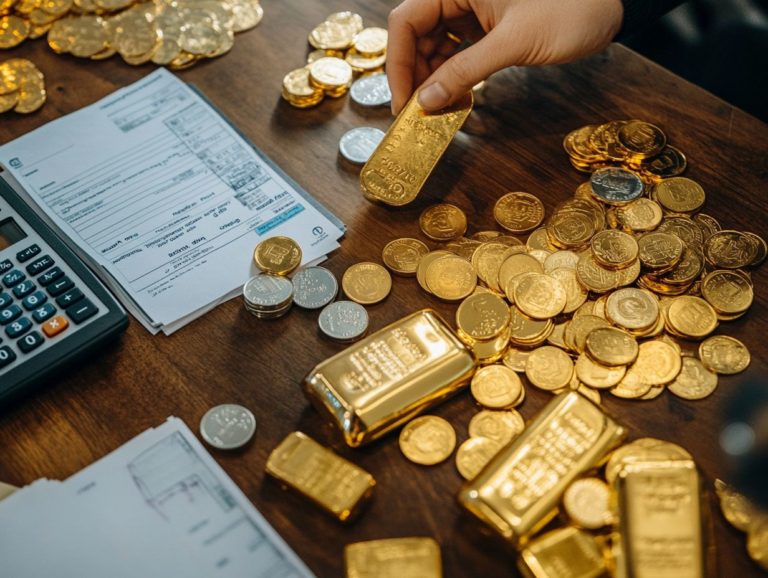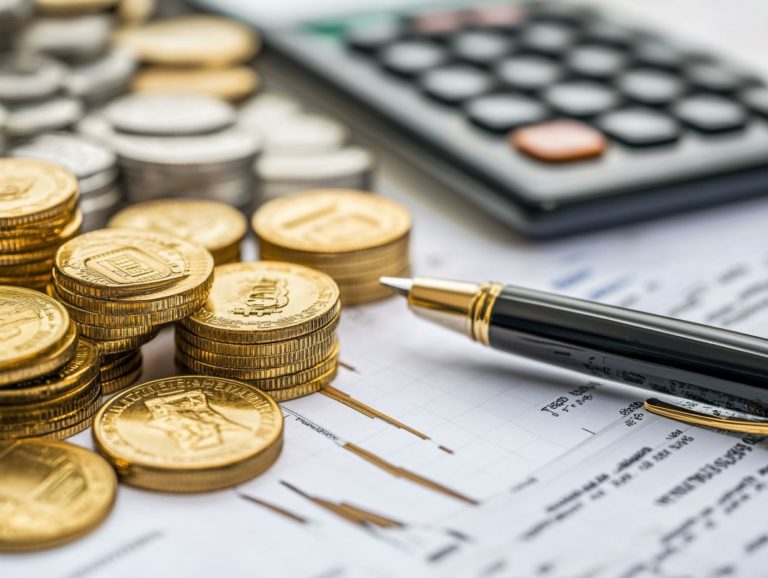How to Approach Tax Season as a Precious Metals Investor
Tax season can feel overwhelming, but for precious metals investors, it presents a distinct set of challenges and opportunities that require your attention.
Understanding the tax implications of your investments is essential. As you explore the advantages of diversifying your portfolio, this guide outlines everything you need to know about investing in precious metals. It covers the distinctions between physical and paper assets and tax strategies that can help you maximize your savings.
It also highlights common pitfalls to avoid and provides valuable resources to navigate the season with confidence. Whether you’re a seasoned investor or just beginning your journey, this guide gives you powerful insights to boost your investment success!
Contents
Key Takeaways:
- Diversify your portfolio with precious metals to hedge against inflation and protect your investments during tax season.
- Understand the tax implications of your precious metals investments and maximize tax savings through proper reporting and tax strategies.
- Utilize resources such as tools and services specifically designed for precious metals investors to make tax season easier and more efficient.
Tax Season for Precious Metals Investors
Tax season presents a unique set of challenges for precious metals investors. The intricate web of tax obligations demands detailed knowledge of several key factors capital gains, income taxes, and the specific regulations enforced by the IRS.
Whether you’re investing in gold, silver, or other precious metals like platinum and palladium, it s essential to comprehend how these investments fit into your broader tax strategy.
Being well-informed about tax implications can profoundly impact your investment choices and financial planning for the year ahead.
Understanding Tax Implications
Understanding the tax implications of investing in precious metals like gold and silver is crucial. It significantly impacts your income taxes and capital gains assessments mandated by the IRS.
Remember, precious metals are classified as collectibles, which subjects them to a maximum tax rate of 28% on capital gains this is higher than the rates for traditional investments like stocks or bonds.
Accurately reporting fluctuations in value is essential for maintaining compliance. For example, losses from these assets can offset gains, but they require meticulous documentation on your part.
You should also be aware that the rules can differ based on the type of metals and their forms, whether they are bullion, coins, or other formats. Given these complexities and the potential financial implications, navigating tax implications of precious metals futures is crucial. Consulting a financial advisor can provide you with tailored advice that aligns with your individual investment goals.
Benefits of Investing in Precious Metals
Investing in precious metals presents an array of advantages that can significantly elevate your investment portfolio. It not only offers diversification but also serves as a robust hedge against inflation.
This makes it an enticing option for discerning investors like yourself, who are keen on stabilizing their financial future.
Diversification and Hedging Against Inflation
Diversification and hedging against inflation are two significant benefits of investing in precious metals. They enable you to stabilize your portfolio amidst the unpredictable market.
Historically, gold and silver have shown remarkable resilience during times of economic turmoil. They serve as a safe haven when traditional assets, like stocks and bonds, may stumble.
For instance, during the 2008 financial crisis, while many equities took a nosedive, gold prices skyrocketed, showcasing its role as a protective asset.
As inflation gnaws away at the purchasing power of fiat currencies, these metals usually hold their value or even appreciate. This makes them an appealing choice compared to cash or real estate.
This historical context underscores the idea that incorporating precious metals into your investment strategy can effectively mitigate the risks tied to inflationary pressures.
Start your journey toward financial security today by diving deeper into precious metals investing!
Types of Precious Metals Investments
Understanding the various types of precious metal investments is essential for crafting effective investment strategies. These investments encompass a spectrum of options, including tangible assets like coins and bars. They also cover financial instruments such as exchange-traded funds (ETFs), which are investment funds traded on stock exchanges that hold precious metals.
By familiarizing yourself with these diverse avenues, you can make informed decisions that align with your investment goals.
Physical vs. Paper Investments
When considering precious metals, you often face a choice between physical investments like gold and silver coins or bars and paper investments, such as exchange-traded funds that track the performance of these precious metals.
This decision carries significant implications for market value, liquidity, and your overall investment strategy. Physical investments offer a tangible asset to hold and store, providing a reassuring sense of security that many investors find attractive. This option also involves storage costs, insurance requirements, and potential challenges with resale.
On the flip side, paper investments offer convenience and lower transaction costs but can be prone to greater volatility and less direct control over your assets. Each approach influences long-term capital gains and tax implications differently. It s essential to weigh these factors carefully in your overall financial planning.
Tax Strategies for Precious Metals Investors
Implementing effective tax strategies as a precious metals investor is crucial for maximizing your tax savings and minimizing capital gains liabilities. This proactive approach enables you to better manage the financial implications tied to your investments in gold, silver, and other precious metals, ensuring that you make the most of your financial portfolio.
Maximizing Tax Savings
Maximizing tax savings on your precious metals investments requires a strategic approach. This involves a solid understanding of specific tax implications and keen leverage of available investment vehicles.
If you’re looking to optimize your returns, consider utilizing tax-deferred accounts. These accounts allow your investments to grow without the immediate burden of tax liabilities. Being mindful of collectible tax rates, which are higher tax rates that apply to certain collectibles like precious metals, can also make a substantial difference. Additionally, understanding the tax consequences of owning precious metals as a business can be crucial for informed decision-making.
Keeping meticulous records is a game-changer for maximizing your savings! This not only provides the necessary documentation for deductions but can also be invaluable in the event of an audit. Case studies demonstrate that investors who consistently maintained a detailed log of expenses and asset appreciation managed to effectively minimize their tax burdens, especially when it comes to tax reporting for precious metals investments, ultimately leading to greater net gains in their portfolios.
Common Tax Mistakes to Avoid
Navigating the tax landscape for precious metals can present a range of challenges. It is essential to avoid common tax mistakes. Ensuring compliance with IRS regulations while optimizing tax outcomes for your investments is paramount.
By staying informed and meticulous, you can effectively manage your financial journey in this intricate arena.
Tips for Accurate Reporting
To ensure accurate reporting of your precious metals investments, it’s crucial to grasp the forms required by the IRS. These include Form 1040 for income reporting and Form 1099-B for detailing sales of those treasured assets.
You should diligently maintain comprehensive records of all transactions. This includes purchase invoices and sales receipts to support the claims you make on your tax returns. This documentation is vital not only for reporting gains and losses but also for ensuring compliance in the event of an audit.
Familiarizing yourself with how to classify your holdings, whether as collectibles or standard investments, is essential. This classification can significantly affect how your profits are taxed. Engaging a tax professional or accountant who specializes in precious metals can be invaluable, helping you navigate the complexities and ensuring that no detail slips through the cracks. For specific guidance, consider how to prepare for tax season as a precious metals investor, as this minimizes the risk of penalties.
Resources for Tax Season
Utilizing the right resources is crucial for precious metals investors as tax season approaches. This enables you to navigate your tax obligations with ease and optimize your financial strategies confidently.
Get prepared now and take control of your financial future!
Tools and Services for Precious Metals Investors
Explore an exciting range of tools and services designed for precious metals investors.
Tax software specifically for investors can simplify tracking gains and losses, making tax season easier. Financial advisory services provide personalized guidance to help you navigate market fluctuations.
With automated reporting tools, you can document your acquisitions accurately and stay compliant, reducing potential tax liabilities. This combination of technology and expert advice helps you make informed decisions and improves your financial outcomes.
Frequently Asked Questions
1. How do I report my precious metals investments during tax season?
If you have invested in precious metals, make sure to report these investments on Schedule D of your tax return. This includes any gains or losses from selling or trading your metals.
2. Do I have to pay taxes on my precious metals investments?
Yes, you are required to pay taxes on any gains from selling or trading precious metals. However, if you hold onto your precious metals for over a year, you may qualify for a lower tax rate.
3. Is there a difference in how I report physical precious metals versus ETFs?
Yes, the tax reporting for physical precious metals and ETFs (exchange-traded funds) is different. Physical metals are tangible assets reported on Schedule D, while ETFs are reported on Form 8949. Understanding these requirements is important for each type of investment.
4. Can I deduct any losses from my precious metals investments on my taxes?
Yes, if you experience a loss from selling or trading precious metals, you can deduct that loss on your taxes. This can help offset any gains and reduce your overall tax liability.
5. Are there any tax implications if I hold my precious metals in a self-directed IRA?
No, investing in precious metals through a self-directed IRA does not have immediate tax implications. However, when you take distributions from your IRA, they will be taxed as regular income.
6. Are there any tax benefits to investing in precious metals?
While precious metals do not offer tax breaks, they can be beneficial for diversifying your portfolio and protecting against inflation. Investing in precious metals can also provide a hedge against economic uncertainty, making it a valuable asset during tax season.














